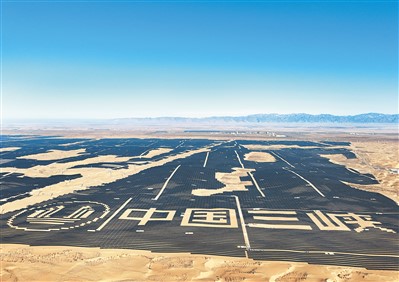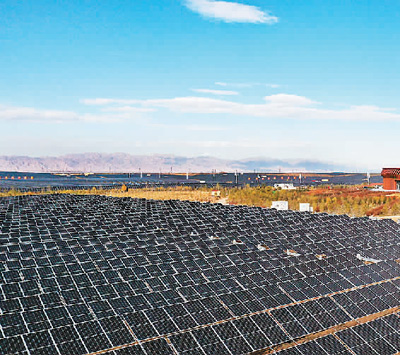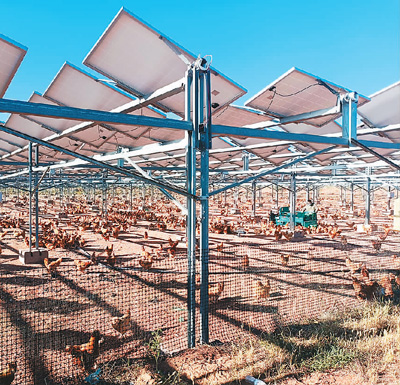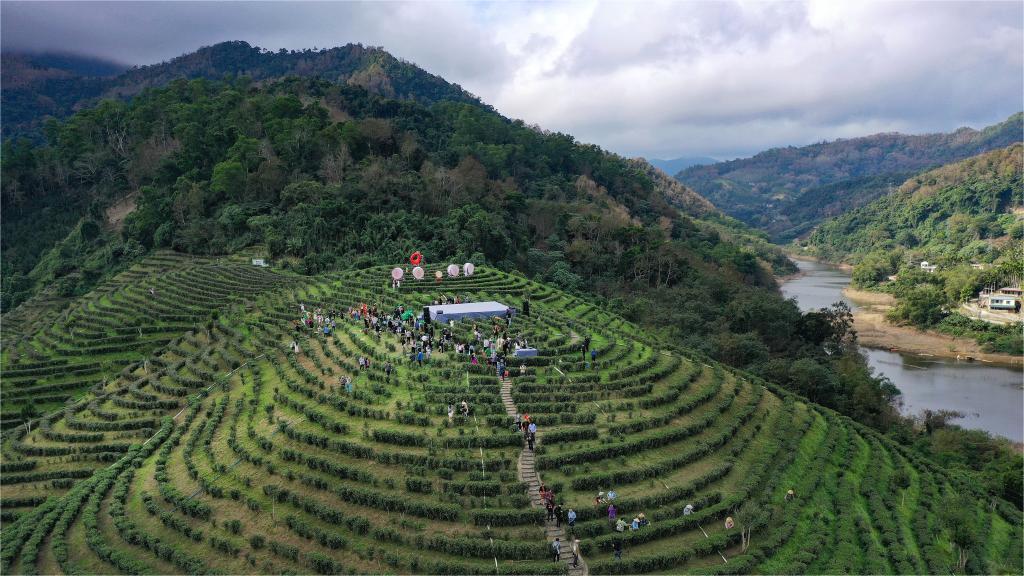New highlights of China's largest desert control PV project in Inner Mongolia
China's largest desert control photovoltaic (PV) project in the Kubuqi desert, north China's Inner Mongolia Autonomous Region, was connected to the power grid on Nov. 29, 2023.
It is one of the first large wind and PV power bases to start construction during the country's 14th Five-Year Plan (2021-25) period.

Photo shows a bird's-eye view of the 2 million-kilowatt Kubuqi desert control photovoltaic project in Duguitala township, Hangjin Banner, Erdos city, north China's Inner Mongolia Autonomous Region. (Photo courtesy of Inner Mongolia Kubuqi Photovoltaic Hydrogen Sand Control New Energy Co., Ltd.)
With an installed capacity of 2 million kW and a land area of 100,000 mu (6,666.67 hectares), the project, located in Duguitala township, Hangjin Banner, Erdos city is expected to generate about 4.1 billion kWh of electricity per year, saving around 1.23 million tonnes of standard coal and reducing carbon dioxide emissions by about 3.19 million tonnes per year.
The Kubuqi desert is the seventh-largest desert in China. "The vast desert with its abundant sunlight provides the necessary land and light resources for PV power generation, while PV panels can reduce water evaporation and wind speed, thus improving the ecological environment for plants," said Zhao Jinquan, who is in charge of the construction of the project.
In June 2022, engineers from China Three Gorges Corporation (CTG) came to the Kubuqi desert, embarking on the path of ecological conservation by combining a PV power station with desertification control.
At the end of October 2023, after the successful installation of about 4.4 million PV panels for the PV-assisted desert control project, workers used reeds to pave sand barriers and drones to spread plant seeds for sand fixation, recalled Zhang Haibin, an executive of the project.

Photo shows photovoltaic panels of the 2 million-kilowatt Kubuqi desert control PV project in Duguitala township, Hangjin Banner, Erdos city, north China's Inner Mongolia Autonomous Region. (Photo courtesy of Inner Mongolia Kubuqi Photovoltaic Hydrogen Sand Control New Energy Co., Ltd.)
Multiple innovative technologies were adopted in the PV-assisted desert control project.
"The project is the first of its kind to use flexible PV supports on a large scale in desert areas in China," said Wang Jiye, another of the project’s executives.
According to Wang, the flexible PV supports are at least 3 meters above the ground and the span of a PV support is 32 meters, creating conditions for the development of an ecological desert control PV system that combines PV power generation with ecological restoration, agriculture and animal husbandry.
The double-glass PV modules can increase power generation by 5 to 10 percent, while quality grass and medicinal herbs are grown under the PV panels, and chickens and sheep can be raised in the field.
Under this new model of ecological conservation, the planting of grass and medicinal herbs under PV panels and the development of animal husbandry help prevent the spread of the desert, while PV panels help reduce ground temperatures and water evaporation and preserve soil moisture levels.
"After completion, the project can help restore 100,000 mu of desert and prevent an average of 2 million tonnes of sand from flowing into the Yellow River annually, which will effectively build an ecological security barrier for the upper reaches of the Yellow River and the Beijing-Tianjin-Hebei region," said Zhang.

Photo shows the green landscape of the 2 million-kilowatt Kubuqi desert control photovoltaic project in Duguitala township, Hangjin Banner, Erdos city, north China's Inner Mongolia Autonomous Region. (Photo courtesy of Inner Mongolia Kubuqi Photovoltaic Hydrogen Sand Control New Energy Co., Ltd.)
During the desertification control process, two workers can plant a tree sapling in only 10 seconds using a water jet under the guidance of engineers based on wind direction big data. In addition, drones equipped with a satellite positioning and navigation system significantly improve the efficiency of afforestation and grass planting.
After more than one year of efforts, the project's afforestation area has surpassed 3,000 mu, and over 10,000 mu of grass grid sand barriers and more than 10,000 mu of reed sand barriers have been built.
Meanwhile, the world's first commercial megawatt-level perovskite ground PV project, as part of the PV-assisted desert control project, was successfully connected to the grid.

Photo shows chickens raised under solar panels of the 2 million-kilowatt Kubuqi desert control photovoltaic project in Duguitala township, Hangjin Banner, Erdos city, north China's Inner Mongolia Autonomous Region. (Photo courtesy of Inner Mongolia Kubuqi Photovoltaic Hydrogen Sand Control New Energy Co., Ltd.)
Perovskite is a new type of solar cell material that is highly efficient, stable and inexpensive, making it essential for the future of photovoltaic technology development.
"CTG will continue to explore the application of perovskite modules in other typical climatic environments to provide data support for the further promotion of commercial applications of perovskite modules and contribute to scientific and technological innovation in the energy field," Zhang said.
Additionally, the PV-assisted desert control project has driven local economic development and employment of farmers and herdsmen. During the construction of the project, jobs for over 1,000 people were created. Also, 500 people are expected to be recruited annually for panel cleaning, growing of crops and stock breeding during the operation of the project.
"With the further development of desertification control and the improvement of the environment, Duguitala township will attract various investment and development projects and gradually ensure sustainable growth. Upon completion of the project, this area covered with PV panels like a vast 'blue sea' can be turned into a tourist attraction to boost local tourism development," Zhao said.
Photos
Related Stories
- In pics: Water-surface PV project in E China's Jiangxi
- China Germany's top supplier of PV systems: Destatis
- China’s PV products gain popularity overseas
- China's PV industry reports robust expansion in 2022
- PV park in NW China's Qinghai contributes to sustainable development
- China's PV exports value 28 bln U.S. dollars in 2021
Copyright © 2024 People's Daily Online. All Rights Reserved.









